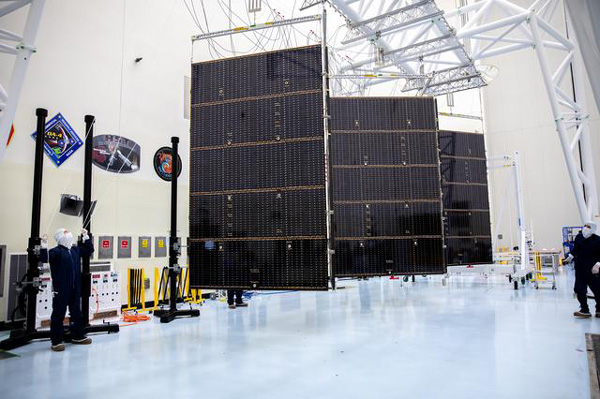 EHT Collaboration
Astronomers Unveil Strong Magnetic Fields Spiraling at the Edge of Milky Way’s Central Black Hole (Press Release)
CfA astronomers led two new EHT studies that have produced the first polarized light image of the supermassive black hole at the heart of the Milky Way galaxy.
Cambridge, MA —
EHT Collaboration
Astronomers Unveil Strong Magnetic Fields Spiraling at the Edge of Milky Way’s Central Black Hole (Press Release)
CfA astronomers led two new EHT studies that have produced the first polarized light image of the supermassive black hole at the heart of the Milky Way galaxy.
Cambridge, MA — A new image from the Event Horizon Telescope
(EHT) Collaboration — which includes scientists from the Center for Astrophysics | Harvard & Smithsonian
(CfA) — has uncovered strong and organized magnetic fields spiraling from the edge of the supermassive black hole Sagittarius A*
(Sgr A*). Seen in polarized light for the first time, this new view of the monster lurking at the heart of the Milky Way galaxy has revealed a magnetic field structure strikingly similar to that of the black hole at the center of the M87 galaxy, suggesting that strong magnetic fields may be common to all black holes.
This similarity also hints toward a hidden jet in Sgr A*. The results were published today in
The Astrophysical Journal Letters.
Scientists unveiled the first image of Sgr A* — which is approximately 27,000 light-years away from Earth — in 2022, revealing that while the Milky Way's supermassive black hole is more than a thousand times smaller and less massive than M87’s, it looks remarkably similar. This made scientists wonder whether the two shared common traits outside of their looks.
To find out, the team decided to study Sgr A* in polarized light. Previous studies of light around M87* revealed that the magnetic fields around the black hole giant allowed it to launch powerful jets of material back into the surrounding environment.
Building on this work, the new images have revealed that the same may be true for Sgr A*.
"What we're seeing now is that there are strong, twisted and organized magnetic fields near the black hole at the center of the Milky Way galaxy," said Sara Issaoun, CfA NASA Hubble Fellowship Program Einstein Fellow, Smithsonian Astrophysical Observatory
(SAO) astrophysicist, and co-lead of the project. "Along with Sgr A* having a strikingly similar polarization structure to that seen in the much larger and more powerful M87* black hole, we’ve learned that strong and ordered magnetic fields are critical to how black holes interact with the gas and matter around them."
Light is an oscillating, or moving, electromagnetic wave that allows us to see objects. Sometimes, light oscillates in a preferred orientation, and we call it "polarized."
Although polarized light surrounds us, to human eyes it is indistinguishable from "normal" light. In the plasma around these black holes, particles whirling around magnetic field lines impart a polarization pattern perpendicular to the field.
This allows astronomers to see in increasingly vivid detail what's happening in black hole regions and map their magnetic field lines.
"By imaging polarized light from hot glowing gas near black holes, we are directly inferring the structure and strength of the magnetic fields that thread the flow of gas and matter that the black hole feeds on and ejects," said Harvard Black Hole Initiative Fellow and project co-lead Angelo Ricarte. "Polarized light teaches us a lot more about the astrophysics, the properties of the gas, and mechanisms that take place as a black hole feeds."
But imaging black holes in polarized light isn’t as easy as putting on a pair of polarized sunglasses, and this is particularly true of Sgr A*, which is changing so fast that it doesn’t sit still for pictures. Imaging the supermassive black hole requires sophisticated tools above and beyond those previously used for capturing M87*, a much steadier target.
CfA postdoctoral fellow and SAO astrophysicist Paul Tiede said, "It is exciting that we were able to make a polarized image of Sgr A* at all. The first image took months of extensive analysis to understand its dynamical nature and unveil its average structure. Making a polarized image adds on the challenge of the dynamics of the magnetic fields around the black hole. Our models often predicted highly-turbulent magnetic fields, making it extremely difficult to construct a polarized image. Fortunately, our black hole is much calmer, making the first image possible."
Scientists are excited to have images of both supermassive black holes in polarized light because these images, and the data that comes with them, provide new ways to compare and contrast black holes of different sizes and masses. As technology improves, the images are likely to reveal even more secrets of black holes and their similarities or differences.
Michi Bauböck, postdoctoral researcher at the University of Illinois Urbana-Champaign, said, "M87* and Sgr A* are different in a few important ways: M87* is much bigger, and it’s pulling in matter from its surroundings at a much faster rate. So, we might have expected that the magnetic fields also look very different. But in this case, they turned out to be quite similar, which may mean that this structure is common to all black holes. A better understanding of the magnetic fields near black holes helps us answer several open questions—from how jets are formed and launched to what powers the bright flares we see in infrared and X-ray light."
The EHT has conducted several observations since 2017 and is scheduled to observe Sgr A* again in April 2024. Each year, the images improve as the EHT incorporates new telescopes, larger bandwidth and new observing frequencies.
Planned expansions for the next decade will enable high-fidelity movies of Sgr A*, may reveal a hidden jet, and could allow astronomers to observe similar polarization features in other black holes. Meanwhile, extending the EHT into space will provide sharper images of black holes than ever before.
The CfA is leading several major initiatives to sharply enhance the EHT over the next decade. The next-generation EHT
(ngEHT) project is undertaking a transformative upgrade of the EHT, aiming to bring multiple new radio dishes online, enable simultaneous multi-color observations, and increase the overall sensitivity of the array.
The ngEHT expansion will enable the array to make real-time movies of supermassive black holes on event horizon scales. These movies will resolve detailed structure and dynamics near the event horizon, bringing into focus "strong-field" gravity features predicted by General Relativity as well as the interplay of accretion and relativistic jet-launching that sculpts large-scale structures in the Universe.
Meanwhile, the
Black Hole Explorer (BHEX) mission concept will extend the EHT into space, producing the sharpest images in the history of astronomy. BHEX will enable the detection and imaging of the "photon ring" – a sharp-ring feature formed by strongly-lensed emission around black holes.
The properties of a black hole are imprinted on the size and shape of the photon ring, revealing masses and spins for dozens of black holes, in turn showing how these strange objects grow and interact with their host galaxies.
Source: Harvard & Smithsonian






















